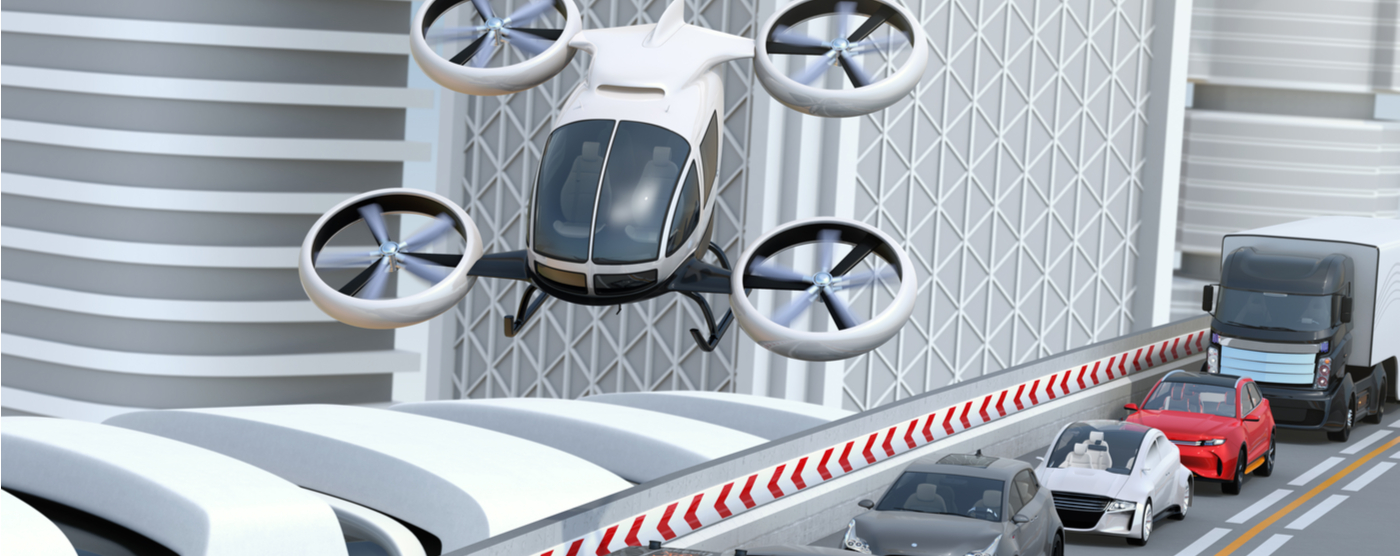Urban Air Mobility: Transforming Sky Transportation

What do you think of when you hear the term, “flying cars”? Maybe a sci-fi movie or even a throwback to an old cartoon comes to mind, where a futuristic object would transport passengers in the air instead of on the ground. How cool was that, right? The reality, however, is that the future is in the making. Wondering how this could be possible? Remember these three words: “urban air mobility.”
What is urban air mobility?
The National Aeronautics and Space Administration (NASA) defines urban air mobility as a “system for air passenger and cargo transportation within an urban area, inclusive of small package delivery and other urban unmanned aircraft systems services.” In other words, NASA’s vision of this new era in air travel is ensuring safe and efficient air transportation as a revolutionary way of safely moving people and cargo from one place to another in congested environments.
How many times have you sat in traffic and wished you could fly over the gridlock? Urban air mobility could change that, as small air taxis are the next generation of autonomous electric passenger air vehicles (PAV) that could fly small groups of travelers above populated areas faster and cleaner than ground vehicles.
NASA is exploring the reality of urban air mobility, thanks to the combined efforts of new business models and transportation technology tied to both aviation―and some outside the industry―to determine what is required to make it happen. The urban air mobility subproject of NASA’s Air Traffic Management Exploration project (ATM-X) is currently in the process of exploring various use cases and testing technologies to with stakeholders in the aviation community.
Safety first
Admit it. The safety factor crossed your mind when you first read about urban air mobility. The thought of travelling in a “flying car”―as fun as that may sound―would make anyone think twice. And with good reason. Urban air mobility operations use unmanned aircraft (UA), which operate with no pilot on board. Today, small delivery drones are in operation, but when it comes to securing the acceptance of regulators and the general public for passenger use, the stakes go up. Here’s why: Without a pilot on board, there’s nobody to “see and avoid” potential collisions with other airspace users, severe weather conditions and other dangerous situations such as flying near bridges, buildings and other man-made structures.
The good news is that even considering the challenges, NASA says they have a handle on it. They are working with the Federal Aviation Administration (FAA) and other government agencies, along with airspace operators, vehicle developers and academia to identify and overcome significant barriers and challenges. On the flip side, urban air mobility comes with substantial cost advantages over traditional ground travel and air transportation which require heavy infrastructure such as roads, rail, bridges, tunnels or airports—not to mention a significant reduction in a traveler’s commute time.
Investing in the future
Recent NASA-commissioned market studies revealed that by the year 2030, as many as 500 million flights per year for package delivery services and 750 million flights per year in air metro services could catapult urban air mobility as a relevant and lucrative enterprise.
According to the groundbreaking study, “Urban Air Mobility―Economics and Global Markets,” published by Nexa Advisors and the Vertical Flight Society, $318 billion could be invested over the next 20 years to transform urban air mobility in 74 cities around the world. This anticipated value of the urban air mobility market includes the infrastructure of vertiports and air traffic management, along with aircraft operated in-airport shuttle services, on-demand air taxis, emergency services, business aviation and regional point-to-point charters. This report is a first attempt to identify the cost of urban air mobility infrastructure―estimated at $32 billion for all 74 cities by the year 2040―and is intended to guide prospective investors about current transportation issues, congestion and population density, among other factors. Despite the hefty $32 billion price tag, the study suggests potential revenues from this infrastructure could exceed $244 billion.
Do you want to be a part of paving the way towards the adoption of urban air mobility? Check out all of the engineering and technology degrees available at Vaughn, as well as the many opportunities to participate in various engineering clubs such as Robotics Club and Unmanned Aerial Vehicle (UAV) Club that allow hands-on design and construction of transportation technology.

